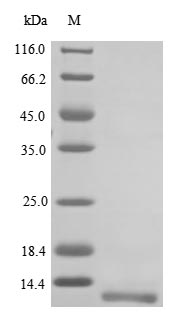Recombinant Mouse Neuropeptide Y receptor type 2 (Npy2r) gets produced in E. coli and contains a partial protein sequence spanning amino acids 1 to 51. The recombinant protein comes with an N-terminal 10xHis-tag that helps with purification and detection. SDS-PAGE analysis confirms the product reaches a purity level above 85%, which appears to make it a solid reagent for research work. This product is strictly for research purposes—not for clinical or diagnostic applications.
Neuropeptide Y receptor type 2 (Npy2r) seems to be a key player in the neuropeptide Y signaling pathway. This pathway likely influences several physiological processes, including how we regulate appetite, experience anxiety, and maintain circadian rhythms. Since Npy2r functions as a G-protein-coupled receptor, it probably modulates intracellular signaling cascades. Neuroscience and metabolic researchers find this receptor particularly interesting. Getting a better grasp of how it works may help us understand more complex biological responses and underlying mechanisms.
Potential Applications
Note: The applications listed below are based on what we know about this protein's biological functions, published research, and experience from experts in the field. However, we haven't fully tested all of these applications ourselves yet. We'd recommend running some preliminary tests first to make sure they work for your specific research goals.
Mouse Npy2r is a GPCR that requires precise folding, proper seven-transmembrane helix formation, membrane integration, and specific tertiary structure for its functional activity in neuropeptide binding and signal transduction. The E. coli expression system cannot provide the necessary eukaryotic membrane environment or post-translational modifications required for this complex transmembrane receptor. The partial fragment (1-51aa) represents only a small N-terminal portion of the full receptor (typically >300aa) and lacks the critical transmembrane domains and ligand-binding sites. The N-terminal 10xHis-tag may further interfere with the protein's structural organization. The probability of correct folding with any functional receptor activity is essentially zero.
1. Antibody Development and Validation
This application has limited utility. While antibodies can be generated against this specific 51aa N-terminal fragment, they will only recognize this small extracellular region and likely won't bind to conformational epitopes of the full-length, membrane-integrated receptor. Antibodies may be useful for detecting this fragment, but not for studying native receptor biology.
2. Biochemical Characterization
Basic biophysical analysis can be performed, but will not reflect native receptor properties. The 51aa fragment is too short and incomplete to provide meaningful insights into GPCR biochemistry. Results will describe a soluble peptide rather than a membrane receptor.
Final Recommendation & Action Plan
This 51aa Npy2r fragment is biologically irrelevant for receptor research and should not be used for any functional studies. The fragment represents less than 20% of the full-length receptor and lacks all critical functional domains (transmembrane helices, ligand-binding site). The only limited application is generating fragment-specific antibodies and basic peptide characterization. Avoid all interaction and binding studies entirely. For authentic Npy2r research, use a full-length protein expressed in mammalian systems with proper membrane integration and ligand-binding capability.






